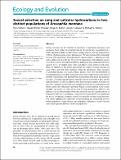Files in this item
Sexual selection on song and cuticular hydrocarbons in two distinct populations of Drosophila montana
Item metadata
| dc.contributor.author | Veltsos, Paris | |
| dc.contributor.author | Wicker-Thomas, Claude | |
| dc.contributor.author | Butlin, Roger | |
| dc.contributor.author | Hoikkala, Anneli | |
| dc.contributor.author | Ritchie, Michael Gordon | |
| dc.date.accessioned | 2012-03-24T00:51:12Z | |
| dc.date.available | 2012-03-24T00:51:12Z | |
| dc.date.issued | 2012-01 | |
| dc.identifier | 16907245 | |
| dc.identifier | abb009d4-9206-4966-bd57-008592414e72 | |
| dc.identifier.citation | Veltsos , P , Wicker-Thomas , C , Butlin , R , Hoikkala , A & Ritchie , M G 2012 , ' Sexual selection on song and cuticular hydrocarbons in two distinct populations of Drosophila montana ' , Ecology and Evolution , vol. 2 , no. 1 , pp. 80 . https://doi.org/10.1002/ece3.75 | en |
| dc.identifier.issn | 2045-7758 | |
| dc.identifier.other | ORCID: /0000-0001-7913-8675/work/46761149 | |
| dc.identifier.uri | https://hdl.handle.net/10023/2459 | |
| dc.description.abstract | Sexual selection has the potential to contribute to population divergence and speciation. Most studies of sexual selection in Drosophila have concentrated on a single signaling modality, usually either courtship song or cuticular hydrocarbons (CHCs), which can act as contact pheromones. We have examined the relationship between both signal types and reproductive success using F1–3 offspring of wild- collected flies, raised in the lab. We used two populations of the Holarctic species Drosophila montana that represent different phylogeographic clades that have been separate for ca. 0.5 million years (MY), and differ to some extent in both traits. Here, we characterize the nature and identify the targets of sexual selection on song, CHCs, and both traits combined within the populations. Three measures of courtship outcome were used as fitness proxies. They were the probability of mating, mating latency, and the production of rejection song by females, and showed patterns of association with different traits that included both linear and quadratic selection. Courtship song predicted courtship outcome better than CHCs and the signal modalities acted in an additive rather than synergistic manner. Selection was generally consistent in direction and strength between the two populations and favored males that sang more vigorously. Sexual selection differed in the extent, strength, and nature on some of the traits between populations. However, the differences in the directionality of selection detected were not a good predictor of population differences. In addition, a character previously shown to be important for species recognition, interpulse interval, was found to be under sexual selection. Our results highlight the complexity of understanding the relationship between within-population sexual selection and population differences. Sexual selection alone cannot predict differences between populations. | |
| dc.format.extent | 14 | |
| dc.format.extent | 1955202 | |
| dc.language.iso | eng | |
| dc.relation.ispartof | Ecology and Evolution | en |
| dc.subject | Courtship song | en |
| dc.subject | Cuticular hrdocarbons | en |
| dc.subject | Drosophila montana | en |
| dc.subject | Selection analysis | en |
| dc.subject | Sexual selection | en |
| dc.subject | QL Zoology | en |
| dc.subject.lcc | QL | en |
| dc.title | Sexual selection on song and cuticular hydrocarbons in two distinct populations of Drosophila montana | en |
| dc.type | Journal article | en |
| dc.contributor.sponsor | NERC | en |
| dc.contributor.institution | University of St Andrews. School of Biology | en |
| dc.contributor.institution | University of St Andrews. Institute of Behavioural and Neural Sciences | en |
| dc.identifier.doi | https://doi.org/10.1002/ece3.75 | |
| dc.description.status | Peer reviewed | en |
| dc.identifier.url | http://doi.wiley.com/10.1002/ece3.75 | en |
| dc.identifier.grantnumber | NE/E015255/1 | en |
This item appears in the following Collection(s)
Items in the St Andrews Research Repository are protected by copyright, with all rights reserved, unless otherwise indicated.

